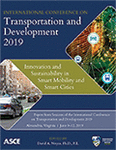International Conference on Transportation and Development 2019
Measuring Fundamental Improvements in Sustainable Urban Mobility: The Mobility-Energy Productivity Metric
Publication: International Conference on Transportation and Development 2019: Innovation and Sustainability in Smart Mobility and Smart Cities
ABSTRACT
Recent technological advancements in mobility are creating many options for connecting citizens with employment, goods, and services, particularly in urban areas where modes such as bike and car shares, electric scooters, ridesourcing, and ridesharing are proliferating at a rapid pace. Analysis and tools for overall transportation planning are dominated by urban regional travel demand models whose roots in highway operations poorly reflect the system dynamics in denser areas where parking costs, convenience, and availability—not to mention sustainability concerns and quality of life—are driving people to an ever-greater spectrum of mobility services. In this paper, we present a new paradigm for evaluating mobility options within an urban area. First developed for the U.S. Department of Energy’s Energy Efficient Mobility System research program, this metric is termed the mobility-energy productivity (MEP) metric. At its heart, the MEP metric measures accessibility and appropriately weights it with travel time, cost, and energy of modes that provide access to opportunities in any given location. The proposed metric is versatile in that it can be computed from readily available data sources or derived from outputs of regional travel demand models. End times associated with parking, curb access, cost, and reliability and frequency of service need to be carefully considered to obtain an appropriate and accurate perspective when computing the metric. Ultimately, the MEP metric can be used to reflect the impacts of new mobility technologies (transportation network companies, electric scooters), business models (car shares and bike shares), and land-use practices (such as transit-oriented development) on sustainable urban mobility. This paper lays out the need, requirements, and framework for this new metric, and offers it, in collaboration with the American Society for Civil Engineers (ASCE), as a foundational metric for smart city assessment.
Get full access to this chapter
View all available purchase options and get full access to this chapter.
ACKNOWLEDGEMENTS
This work was authored by the National Renewable Energy Laboratory, operated by Alliance for Sustainable Energy, LLC, for the U.S. Department of Energy (DOE) under Contract No. DE-AC36-08GO28308. Funding was provided by the DOE Vehicle Technologies Office (VTO) under the Systems and Modeling for Accelerated Research in Transportation (SMART) Mobility Laboratory Consortium Program, an initiative of the Energy Efficient Mobility Systems (EEMS) Program. The authors would particularly like to thank David Anderson, Prasad Gupte and Erin Boyd with DOE’s Office of Energy Efficiency and Renewable Energy (EERE) for providing ongoing guidance and support. The views expressed in the article do not necessarily represent the views of the DOE or the U.S. Government. The U.S. Government retains and the publisher, by accepting the article for publication, acknowledges that the U.S. Government retains a nonexclusive, paid-up, irrevocable, worldwide license to publish or reproduce the published form of this work, or allow others to do so, for U.S. Government purposes.
REFERENCES
All TransitTM(2018). “Discover the Social and Economic Benefits of Transit” <https://alltransit.cnt.org/> (Dec. 16, 2018).
Fuller, J. (2018). “Why did Cars Become the Dominant Form of Transportation in the United States?” <https://auto.howstuffworks.com/cars-dominant-form-transportation.htm> (Dec 16, 2018).
Geurs, K. T., and van Wee, B. (2004). “Accessibility Evaluation of Land-Use and Transport Strategies: Review and Research Directions.” Journal of Transport Geography, Vol. 12, 127–140.
Hou, Y., Garikapati, V. M., Nag, A., Young, S.E., and Grushka, T. (2019). “A Novel and Practical Method to Quantify the Quality of Mobility: The Mobility Energy Productivity Metric.” Submitted to Transportation Research Record. In press.
Oak Ridge National Laboratory. (2018). “National Household Travel Survey” <https://nhts.ornl.gov/> (Dec. 27, 2018)
U.S. Environmental Protection Agency. (2018). “MOVES2014b: Latest Version of Motor Vehicle Emission Simulator” <https://www.epa.gov/moves/latest-version-motor-vehicle-emission-simulator-moves> (Dec. 16, 2018).
Vickerman, R. W. (1974). “Accessibility, Attraction and Potential: A Review of Some Concepts and Their Use in Determining Mobility.” Environment and Planning A: Economy and Space, 1974, Vol. 6, No. 6, 675–691.
Wachs, M., and Kumagai, T.G. (1973). “Physical Accessibility as a Social Indicator.” Socioeconomic Planning Science, Vol. 7, No. 5, 327–456.
Walk Score®(2018). “Live Where You Love” <https://www.walkscore.com/> (Dec. 16, 2018).
Warade, R. K. (2007). “The Accessibility and Development Impacts of New Transit Infrastructure: The Circle Line in Chicago (M.S. Thesis).” MIT, Cambridge, MA.
Young, S., Hou, Y., Garikapati, V., Chen, Y., and Zhu, L. (2017). “Initial Assessment and Modeling Framework Development for Automated Mobility Districts,” in Proceedings of ITS World Congress 2017, Montréal, Québec, Canada.
Information & Authors
Information
Published In
International Conference on Transportation and Development 2019: Innovation and Sustainability in Smart Mobility and Smart Cities
Pages: 111 - 121
Editor: David A. Noyce, Ph.D., University of Wisconsin–Madison
ISBN (Online): 978-0-7844-8258-2
Copyright
© 2019 American Society of Civil Engineers.
History
Published online: Aug 28, 2019
Authors
Metrics & Citations
Metrics
Citations
Download citation
If you have the appropriate software installed, you can download article citation data to the citation manager of your choice. Simply select your manager software from the list below and click Download.
